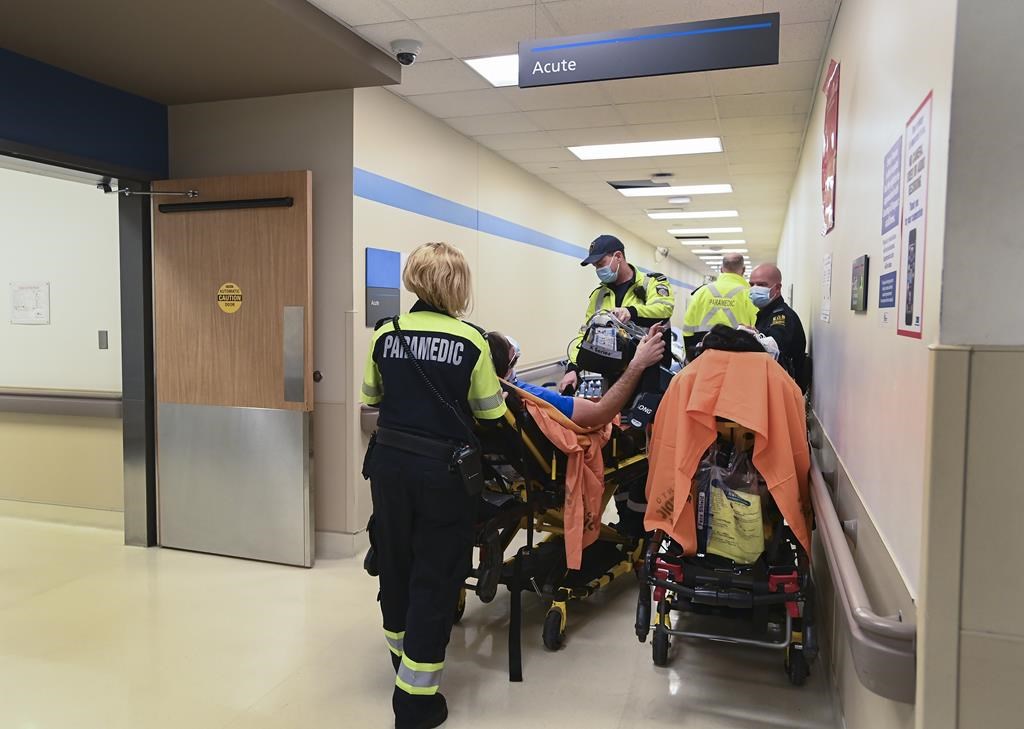Several Ontario hospital leaders say much-needed beds could be freed up by a new law that would move discharged patients awaiting long-term care to nursing homes not of their choosing, although some hope to avoid using it on a broad scale.
The law, which went into effect Wednesday, allows hospitals to send those patients to homes up to 70 kilometres away in southern Ontario and up to 150 kilometres away in northern regions, on a temporary basis. On Nov. 20, hospitals can begin charging patients $400 per day if they refuse to move.
The province said the law – known as Bill 7 – is part of efforts to ease pressure on hospitals, which have seen emergency departments closed for hours or days at a time in recent months and a massive surgical backlog that was exacerbated by the pandemic.
Scarborough Health Network CEO David Graham said the law will help hospitals like his.
“It absolutely opens up access to beds that would allow us to schedule surgeries for those people on long waiting lists,” Graham said in an interview Wednesday.
The hospital in east Toronto was hit “very hard” during the pandemic, but they have not had to close or reduce hours in any department due to staffing issues, Graham noted.
The law applies to patients who have been discharged, but need an “alternate level of care” than the acute care provided at a hospital.
It has sparked outrage from seniors, their caregivers and advocates, who argue it preys on the vulnerable and could move some far away from their loved ones.
Graham said the law strikes a “balancing act” between finding a better spot for so-called ALC patients and patients who need acute care.
“We think that it’s trying to strike an ability for us to serve both populations in the most appropriate care setting,” he said. “We see (the bill) as being able to provide those services in a more timely manner.”
On any given day in the past week at the Scarborough General Hospital, there are 150 patients who need an alternate level of care, which is about 20 per cent of the hospital’s beds, Graham said.
About half of those patients are awaiting a bed in long-term care, he said. There are several patients in hospital who have been awaiting a nursing home bed for more than 300 days.
In rural southwestern Ontario, the head of a four-hospital network said he applauds the government’s efforts but doesn’t see his hospitals using the powers of the law in the short term.
“I can’t think that it’s going to have a huge impact because there are no empty long-term care beds in this geographic area,” said Huron Perth Healthcare Alliance CEO Andrew Williams.
There are anywhere from 10 to 20 patients across the four hospitals on any given day over the past week who are waiting for a nursing home bed.
“It’s not their fault that we don’t have capacity in the system, but it certainly does impact others who may need the bed and may need intervention and benefit, obviously, from coming in quicker,” Williams said.
“I cannot fault the government for trying to put policies in place that may help in some parts of the province, but just in our particular reality, in our smaller rural communities, that particular avenue is likely not going to have a significant impact.”
There are 107 long-term care homes within the 70-kilometre radius of the network’s hospitals, but it’s not simply a matter of finding empty beds in a farther-flung locale, he said.
“There are going to be other hospitals much, much closer to that long-term care home where people would take the beds ahead of ours,” Williams explained. “So there’s a lot of moving parts.”
Discharged patients staying in hospitals awaiting long-term care has long been a problem, said Kevin Smith, CEO of the University Health Network that runs three large Toronto hospitals, several rehabilitation hospitals and several long-term care homes.
The health-care system, both in acute care and long-term care, has not kept up with an aging population, he said.
“The population of patients who need acute care have to be provided that acute care in a hospital because there’s nowhere else you can actually do that,” Smith said.
“Because there are people there that can be safely cared for in another lower-acuity environment, (it) requires us to have this legislation, which I wish we didn’t have to have it, but we do.”
In the last few months, there are anywhere from 75 to 100 patients who need an alternate level of care on a given day, Smith said, the vast majority of them destined for long-term care. That’s about 10 per cent of the 900 acute-care beds across his hospital system.
He said the hospital network will implement the new powers cautiously, but held out hope they won’t have to use them.
“I think it’ll be almost no one who we get to the point of really forcing them to go to somewhere they don’t want to go to,” Smith said. “And if we did get there, shame on us.”
He said any extra beds will help with the surgical backlog, which has hit about 6,000 pending surgeries at his network – that figure stood at about 200 before the pandemic hit.
The province said the new rules will help free up at least 250 hospital beds in the first six months.
This report by The Canadian Press was first published Sept. 21, 2022.



